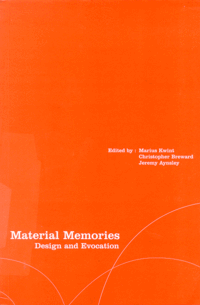

![]()
![]()

The book contains a collection of essays by cultural historians who interrogate a range of objects including; buildings, photographs, samplers, a shipwreck, embroidered banners, street signs, accouchement sets and hair jewellery. The essayists came together for a conference organised by the Victoria and Albert Museum and the Royal College of Art and their contributions show a remarkable consistency of approach as they set the objects in their time. The writing is fluid and evocative, presenting factual details and arranging series of related objects while drawing out meanings through a number of devices; psychoanalysis, literary sources, cultural theory. Proust's recovery of memory with the help of a dipped biscuit provides a reference that reoccurs - this story is presented most engagingly in Marius Kwint's scene setting introduction. Taste is not however the dominant sense referred to in Material Memories because most of the objects are those that provoke the senses of sight or touch. Opposite the contents page is a poem by Bernard O'Donaghue that begins 'If you doubt, you can put your fingers / In the holes...' but of course most of the objects considered here are too precious to be touched. Recently I watched enviously as a small child, lifted up close to see a tiny Rembrandt drawing, innocently put out a finger to touch the image. The way that touch seems to bring a thing to life and release its potential for stimulating memory is explored in Susan Stuart's account that recognises the 'no touch' policy of museums as limiting our capacity to be moved.
There are a number of high quality black and white photographs reproduced in this book that help somewhat with not being able to either see or touch the objects discussed. Sight and touch are brought together in Elizabeth Edwards's discussion of the materiality of photographs that are framed, stroked and ripped up. On the other hand, it is the proximity not tactility of human hair made into jewellery that evokes the real presence of the dead. As Marcia Pointon puts it: '... the resilient nature of hair as a medium produces a bouncy, resistant feel that is too organic (like springy bits of offal) to be pleasant at least to the modern touch' (page 55).
Buildings - monuments (Benton), stately mansions (Mandler), the homes of collector / designers (Naylor; Ryan) - provide an opportunity for adaptation and manipulation so that those who remember can construct their memories out of the material. For example, Tim Benton describes the 'military castration' of memorials by removing their arms and weapons and Peter Mandler the way that engravings and guidebooks ideologically framed the historic houses that entertained the new mass tourists of the Victorian age. The work of memory is clearly ideological, reconstructing our cultural past in ways that enhance its value for us. This produces effects such as the 'age-value' that Mandler mentions (page 137) and Walter Benjamin's 'fancier-value' (page 119) that takes the collector's object out of the use-value/exchange-value circuit. Benjamin is referred to by a number of contributors but is the subject of Esther Leslie's fascinating account of how his memories of place are tied up with his relationships and feelings.
Of course this book, with its scholarly care, photographs, facts, references and lyrical writing, is itself an object that ideologically remembers the way other objects and other lives are intertwined. It seems that it is those rich in time and money who are most likely to be remembered or to choose how objects will shape future memories - the confessional sampler that Elizabeth Parker writes of is an exception. In its best moments this book goes further than just remembering by unfolding the emotional need to engage with the analogical record of objects that store experience beyond individual memory.
Tim Dant
University of East Anglia